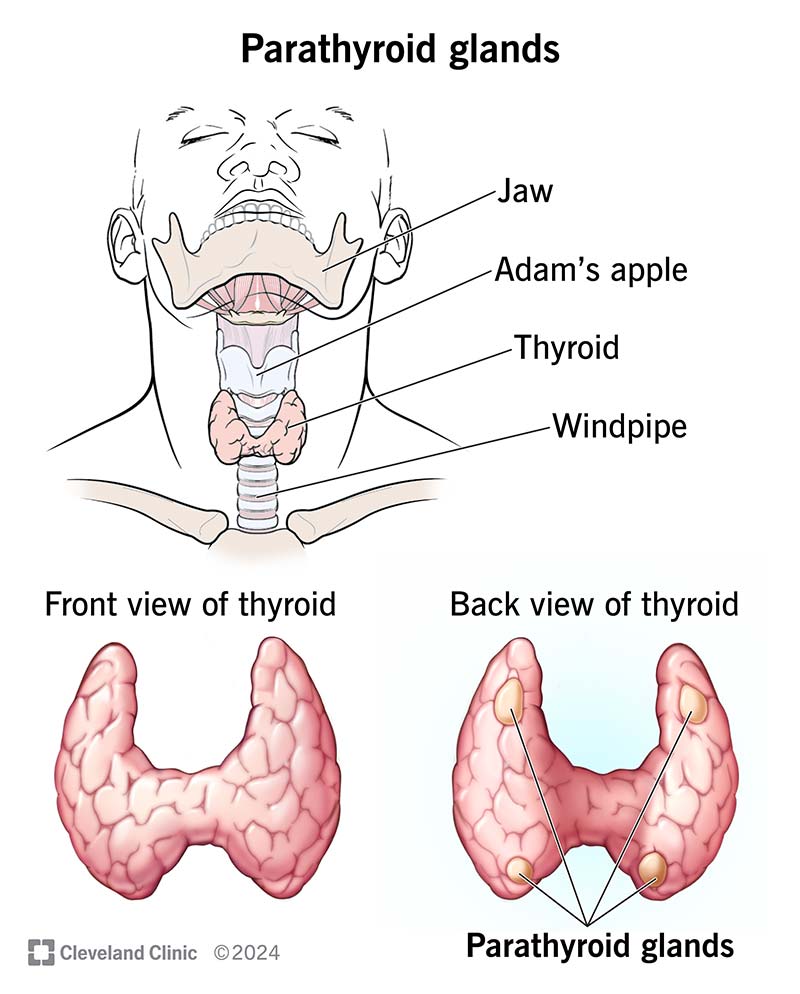Most people have four tiny parathyroid glands behind their thyroids in their necks. These glands have the important job of keeping your blood calcium levels stable. Issues with your parathyroid glands can cause high or low blood calcium levels, which require treatment.
Advertisement
Cleveland Clinic is a non-profit academic medical center. Advertising on our site helps support our mission. We do not endorse non-Cleveland Clinic products or services. Policy

Your parathyroid glands are four pea-sized endocrine glands that are embedded within the back side of your thyroid. They produce and release parathyroid hormone (PTH). This hormone is responsible for controlling blood calcium levels.
Advertisement
Cleveland Clinic is a non-profit academic medical center. Advertising on our site helps support our mission. We do not endorse non-Cleveland Clinic products or services. Policy
Most people have four parathyroid glands. But studies show that some people have fewer or more than four.
Your parathyroid glands have one job: making and releasing parathyroid hormone (PTH). Together, PTH and another hormone — calcitonin — tightly control the levels of calcium in your bloodstream. Having too much or too little calcium in your blood can be associated with health issues.
Calcium is one of the most important and common minerals in your body. About 99% of your body’s calcium is stored in your bones and teeth, while the other 1% of it circulates in your blood. Although it may be a small amount, the calcium in your blood is essential and helps:
Vitamin D also plays an important role in maintaining blood calcium levels because your body needs it to absorb calcium.
Most people (around 80%) have four parathyroid glands embedded behind their thyroid gland — the butterfly-shaped gland in your neck. There are typically two parathyroid glands within each “wing” of your thyroid.
Sometimes, your parathyroid glands are located along your esophagus in your neck or in your chest (in your mediastinum, specifically). Healthcare providers call these ectopic (in an abnormal place) parathyroid glands. Around 16% of people have ectopic parathyroid glands.
Advertisement
Ectopic parathyroid glands usually aren’t a cause for concern. But if one or more are releasing too much PTH and you need to have them removed, it may be difficult for your healthcare provider to find them at first.
Your parathyroid glands are tiny — each about the size and shape of a pea. In some people, parathyroid glands may become overactive and enlarged.
The two main health conditions involving your parathyroid glands are hyperparathyroidism and hypoparathyroidism.
Hyperparathyroidism happens when one or more of your parathyroid glands become overactive and release too much parathyroid hormone.
Your parathyroid glands may do this naturally:
Healthcare providers call this secondary hyperparathyroidism. If this process lasts for a long time, it could lead to other health issues.
In other cases, your parathyroid glands may be overactive in a way that causes the levels of calcium in your blood to rise (hypercalcemia). Providers call this primary hyperparathyroidism. It happens when there’s something directly affecting your parathyroid glands. About 100,000 people in the United States develop it each year.
Since providers often discover hypercalcemia in its early stage, most people don’t have symptoms from primary hyperparathyroidism.
More severe and/or long-term cases of hypercalcemia may cause the following symptoms:
A parathyroid adenoma is a benign (noncancerous) growth that appears on one or more of your parathyroid glands. It’s the most common cause of primary hyperparathyroidism.
Parathyroid cancer can also cause primary hyperparathyroidism. But It’s very rare. Parathyroid cancer accounts for 0.005% of all cancers and 0.5% to 1% of all parathyroid conditions.
Hypoparathyroidism is a rare condition that happens when you have low levels of parathyroid hormone in your blood. This causes you to have low levels of calcium (hypocalcemia) and high levels of phosphorous (hyperphosphatemia) in your blood.
Approximately 75% of hypoparathyroidism cases are from accidental damage to your parathyroid glands from neck or thyroid surgery. There are other causes, too, like certain genetic and autoimmune conditions.
Advertisement
If the cause isn’t due to surgery, in most cases, hypoparathyroidism progresses very gradually and symptoms can be mild. Symptoms include:
Your parathyroid glands are nestled behind your thyroid, so they’re usually not easily damaged or injured. There’s not much you need to do to keep these glands healthy. But there are steps you can take to help your parathyroid glands keep your blood calcium level in a healthy range:
Your parathyroid glands are tiny but mighty glands that are essential for keeping your blood calcium levels stable. Most people don’t think about them — or haven’t heard of them — until there’s an issue. If you have symptoms of high or low blood calcium levels, let your healthcare provider know. They can recommend simple blood tests to get to the bottom of the cause.
Advertisement
Cleveland Clinic treats all parathyroid diseases, including cancer, and their side effects. We’ll create a personalized treatment plan that meets your needs.

Last reviewed on 05/13/2024.
Learn more about the Health Library and our editorial process.